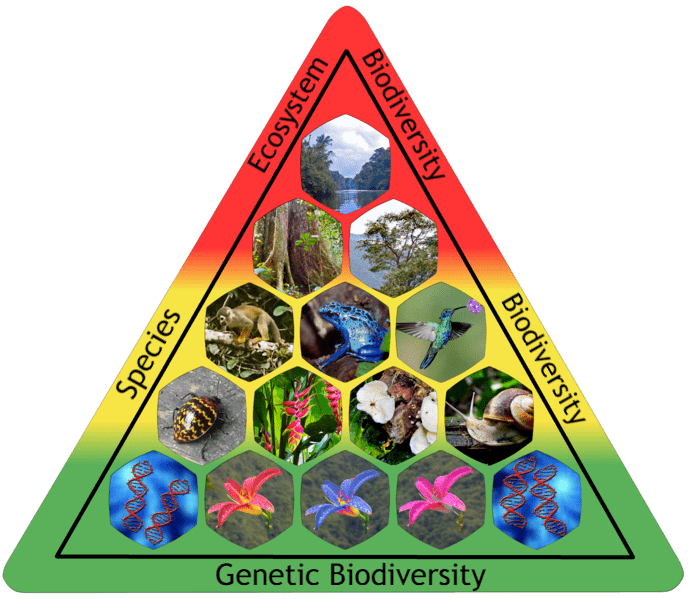What We Review
Introduction
Ecological biodiversity covers everything from the smallest bacteria in soil to the largest mammals on land. Therefore, it is essential for students to understand how biodiversity supports life on Earth. Biodiversity connects to many AP® Biology concepts, including ecosystem interactions and evolutionary processes. Moreover, it helps students appreciate why preserving habitats and preventing biodiversity loss matters on a global scale.
This article explains ecological biodiversity step by step. It aims to define biodiversity, explore why biodiversity is important, and discuss how various factors affect the balance of ecosystems. The following sections guide students in understanding key terms, examples, and real-life applications of biodiversity in the natural world.
Defining Ecological Biodiversity

Biodiversity refers to the variety of life in a particular habitat or across the entire planet. It includes:
- Genetic diversity (differences in genetic makeup within a species),
- Species diversity (the number of different species in an area), and
- Ecosystem diversity (the range of different habitats or ecosystems in a region).
Therefore, the greater the variety of organisms and environments, the more an area is considered rich in biodiversity. When scientists define biodiversity, they often measure how balanced and varied a community of organisms is in that environment.
Example: Rainforest vs. Desert
A tropical rainforest has high species diversity because it contains numerous plant, animal, and microorganism species. In contrast, a desert typically has fewer species but might possess unique adaptations such as water-storing cacti and nocturnal animals.
- Step-by-step exploration of these two ecosystems:
- Identify how many species exist in the rainforest vs. the desert.
- Note how each species adapts (e.g., rainforest frogs need moisture, desert reptiles conserve water).
- Compare how differently each environment provides resources like food and shelter.
Each habitat is vital, though the rainforest has more overall species diversity. However, even deserts have specially adapted organisms that thrive in harsh conditions, highlighting ecosystem diversity.
Importance of Biodiversity in the Biosphere
Biodiversity is crucial because it provides ecosystems with the services needed to function properly. These services include:
- Pollination of plants (vital for fruit and crop production),
- Water purification by wetlands, and
- Nutrient cycling in soil by bacteria and fungi.
Moreover, biodiversity offers direct economic benefits, such as new pharmaceutical discoveries derived from plant compounds. It also helps develop crops with disease resistance and greater yield, supporting agriculture.
When biodiversity loss occurs, ecosystems can collapse or lose efficiency. Therefore, many regions face threats like lower crop productivity or polluted water sources. This situation highlights why biodiversity is important for all living things.
Example: A Local Wetland
Local wetlands might filter water, provide flood protection, and support fish populations for human consumption. However, if pollution or invasive species reduce the wetland’s biodiversity, these services will decline.
- Step-by-step case analysis:
- Observe the number of fish, birds, and plant species in a healthy wetland.
- Determine how each species contributes to flood control, water purification, or food sources.
- Compare what happens when invasive species take over or pollution kills native species.
This change may reduce the wetland’s ability to prevent flooding or support healthy fish populations, showing how vital ecological biodiversity is.
The Relationship Between Ecosystem Diversity and Resilience
Ecosystem diversity refers to the number of distinctive habitats within a region. Next, consider how different ecosystems can better withstand disturbances such as disease outbreaks or climate shifts. A region with diverse ecosystems often recovers more quickly because it has multiple habitats that can support species under stress.
Therefore, if one part of the environment is damaged by a storm, organisms can move to another area to survive. This flexibility shows that a region’s diversity of ecosystems supports overall stability.
Example: Coral Reefs vs. a Single-Species Fishery
Coral reefs contain a wide range of organisms, from coral polyps to various fish and invertebrates. In contrast, a single-species fish farm relies on only one species for production.
- Step-by-step comparison:
- Observe how coral reefs support fish, algae, and coral, each helping balance resources like food and shelter.
- Note what happens if disease affects one species. Others may fill the gap, allowing the reef to continue functioning.
- Compare a single-species fishery that collapses rapidly if that one species is hit by disease.
Hence, maintaining diverse ecosystems can buffer against threats and increase resilience.
Role of Keystone Species in Ecosystems
A keystone species is an organism that has an unusually large effect on its environment relative to its abundance. By definition, removing a keystone species causes dramatic changes in an ecosystem, sometimes leading to the disappearance of other species.
Example: Sea Otters in Kelp Forests
Sea otters maintain kelp forest health by preying on sea urchins. Without otters, urchins multiply and overgraze kelp, reducing habitat for fish and other organisms.
- Step-by-step analysis:
- Identify how sea otters feed on sea urchins.
- Observe what happens to kelp when sea urchin populations become too large.
- Note the impact on fish, crustaceans, and other marine life when kelp forests deteriorate.
Thus, keystone species can shape entire ecosystems, emphasizing the importance of each organism’s role.
Impact of Species Addition or Removal on Ecosystems
Adding or removing even a single species can create ripple effects. In the short term, a new predator might control an overabundant prey population, improving biodiversity. However, more significant changes can occur if the prey becomes too scarce or if the predator affects species that were previously stable.
Therefore, it is important to study both short-term gains and long-term consequences before introducing or removing species from an ecosystem.
Example: Reintroduction of Wolves to Yellowstone
In the mid-1900s, wolves were eliminated from Yellowstone National Park, leading to an overpopulation of elk. This situation damaged vegetation and waterways. When wolves were reintroduced in the 1990s, elk numbers declined, allowing plants and trees to recover.
- Step-by-step process:
- Note the elk population’s growth once wolves were removed.
- Observe the environmental stress from overgrazing.
- Track the decrease in elk numbers after wolves were reintroduced.
- See how plant life and habitats for birds and beavers rebounded.
Eventually, the entire ecosystem became more balanced and resilient, showcasing the intricate relationships among species.
Summary of Key Concepts
- Ecological biodiversity includes genetic, species, and ecosystem diversity.
- Biodiversity supports essential services like pollination, water filtration, and nutrient cycling.
- Healthy ecosystems can adapt to disturbances more easily.
- Keystone species, such as sea otters, have powerful effects on habitat structure.
- Introduction or removal of species can transform entire food webs.
Therefore, ecological biodiversity highlights how all organisms interact and rely on one another. Ecosystems remain stable when diverse organisms and habitats coexist, illustrating why biodiversity is important for the planet’s overall health.
Vocabulary Reference Chart
| Term | Definition / Key Features |
| Biodiversity | Variety of life covering genetic, species, and ecosystem levels |
| Ecosystem | Community of organisms interacting with each other and their physical environment |
| Genetic Diversity | Variation of genes within a species |
| Species Diversity | Number of different species in an ecosystem |
| Ecosystem Diversity | Range of different habitats or ecosystems in a region |
| Keystone Species | Organism with a distinct, disproportionate effect on the balance of an ecosystem |
| Biodiversity Loss | Reduction in the variety and abundance of living organisms |
| Ecological Resilience | Ability of an ecosystem to recover from disturbances or changes |
| Invasive Species | Non-native species that spread rapidly and disrupt local ecosystems |
Conclusion
Understanding ecological biodiversity helps in recognizing the importance of balancing organisms and habitats within the biosphere. Biodiversity examples from coral reefs to deserts show how different species rely on each other. Furthermore, key concepts such as keystone species and ecosystem resilience illustrate why biodiversity must be protected.
A biodiverse planet provides humans with countless benefits, from health and food security to stable climates and thriving economies. Therefore, continued study and research in biodiversity conservation can help ensure a vibrant and harmonious biosphere for future generations.
Sharpen Your Skills for AP® Biology
Are you preparing for the AP® Biology test? We’ve got you covered! Try our review articles designed to help you confidently tackle real-world math problems. You’ll find everything you need to succeed, from quick tips to detailed strategies. Start exploring now!
Need help preparing for your AP® Biology exam?
Albert has hundreds of AP® Biology practice questions, free response, and full-length practice tests to try out.








